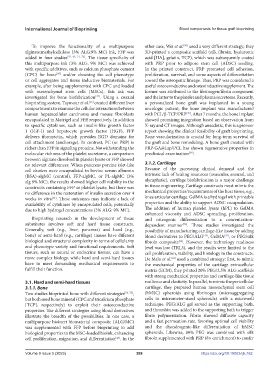Page 296 - IJB-9-5
P. 296
International Journal of Bioprinting Blood components for tissue graft bioprinting
To improve the functionality of a multipurpose other case, Wei et al. used a very different strategy; they
[50]
alginate:methylcellulose (3% ALG:9% MC) ink, FFP was 3D-printed a composite scaffold (silk fibroin, hyaluronic
added in four studies [47, 65, 71, 72] . The tissue specificity of acid [HA], gelatin, TCP), which was subsequently coated
this multipurpose ink (3% ALG, 9% MC) was achieved with PRP prior to adipose stem cell (ADSC) seeding.
with specific additives, such as calcium phosphate cement In the printed construct, PRP promoted cell adhesion,
(CPC) for bone and/or choosing the cell phenotype proliferation, survival, and some aspects of differentiation
[47]
or cell aggregates and tissue inductive biomaterials. For toward the osteogenic lineage. Thus, PRP was considered a
example, after being supplemented with CPC and loaded useful osteoconductive and osteoinductive supplement. The
with mesenchymal stem cells (MSCs), this ink was former was attributed to the fibrinogen/fibrin component
investigated for bone biofabrication . Using a coaxial and the latter to the platelet and plasma secretome. Recently,
[47]
bioprinting system, Taymour et al. created different liver a personalized bone graft was implanted in a young
[65]
compartments to examine the cellular interactions between oncologic patient; the bone implant was manufactured
human hepatocellular carcinoma and mouse fibroblasts with PCL/β-TCP/PRP . After 7 months, the bone implant
[49]
encapsulated in Matrigel and FFP, respectively. In addition showed promising integration based on observation from
to specific cytokines, such as insulin-like growth factor X-ray and CT images. Although anecdotic, this is a pioneer
1 (IGF-I) and hepatocyte growth factor (HGF), FFP report showing the clinical feasibility of graft bioprinting.
delivers fibronectin, which provides RGD domains for Bone vascularization is crucial for long-term survival of
cell attachment (anchorage). In contrast, PC (or PRP) is the graft and bone remodeling. A bone graft created with
richer than FFP in signaling proteins. Notwithstanding the PRP-GA@Lap/PCL has shown regenerative properties in
molecular richness of the platelet secretome, a comparison preclinical examination .
[48]
between alginate dissolved in platelet lysate or FFP showed
no relevant differences. When pancreas porcine islet-like 3.1.2. Cartilage
cell clusters were encapsulated in bovine serum albumin Because of the increasing clinical demand and the
(BSA)-algMC (control), FFP-algMC, or PL-algMC (3% intrinsic lack of healing resources (avascular, aneural, and
alg 9% MC), the results showed higher cell viability in the alymphatic), cartilage biofabrication is a major challenge
constructs containing FFP or platelet lysate, but there was in tissue engineering. Cartilage constructs must mimic the
no difference in the restoration of insulin secretion over 4 mechanical properties/requirements of the host tissue, e.g.,
weeks in vitro . These outcomes may indicate a lack of knee articular cartilage. GelMA is a hydrogel with printable
[71]
availability of cytokines by encapsulated cells, potentially properties and the ability to support ADSC encapsulation.
due to high hydrogel concentrations (3% ALG: 9% MC). The addition of human platelet lysate (hPL) to GelMA
enhanced viscosity and ADSC spreading, proliferation,
Bioprinting research in the development of tissue and osteogenic differentiation in a concentration-
substitutes involves soft and hard tissue constructs. dependent manner . Three studies investigated the
[76]
Generally, soft (e.g., liver, pancreas) and hard (e.g., possibility of manufacturing cartilage-like tissue by adding
bone) or semi-hard (e.g., cartilage) tissues have different blood derivatives to PEG/ALG , GelMA , or PEG/silk
[43]
[52]
biological and structural complexity in terms of cellularity fibroin composite . However, the technology readiness
[53]
and phenotype variety and functional requirements. Soft level was low (TRL3), and the results were limited to the
tissues, such as neural or endocrine tissues, can have a cell proliferation, viability, and histology in the constructs.
more complex biology, while hard and semi-hard tissues De Melo et al. used a combined strategy: first, to mimic
[43]
have to meet demanding mechanical requirements to the mechanical properties of the cartilage extracellular
fulfill their function. matrix (ECM), they printed 20% PEG/2.5% ALG scaffolds
with strong mechanical properties and cartilage-like tissue
3.1. Hard and semi-hard tissues resilience and elasticity. In parallel, to mimic the pericellular
3.1.1. Bone cartilage, they prepared human mesenchymal stem cell
Two studies bioprinted bone with different strategies [50, 72] , (hMSC) spheroids using fibrinogen (microaggregating
but both used bone mineral (CPC and tricalcium phosphate cells in micrometer-sized spheroids) with a microwell
[TCP], respectively) to exploit their osteoconductive technique. PEG/ALG gel served as the supporting bath,
properties. The different strategies using blood derivatives and thrombin was added to the supporting bath to trigger
illustrate the breadth of the possibilities. In one case, a fibrin polymerization. Fibrin showed diffusive capacity
multipurpose bioinert biomaterial composite (ALG/MC) and a fast permeation rate, favoring optimal cell viability
was supplemented with FFP before bioprinting to add and the chondrogenic-like differentiation of hMSC
biological properties to the MSC-loaded bioink, enhancing spheroids. Likewise, 80% PEG was combined with silk
cell proliferation, migration, and differentiation . In the fibroin supplemented with PRP (8× enrichment) to confer
[47]
Volume 9 Issue 5 (2023) 288 https://doi.org/10.18063/ijb.762

